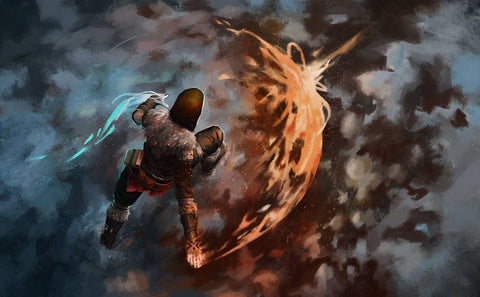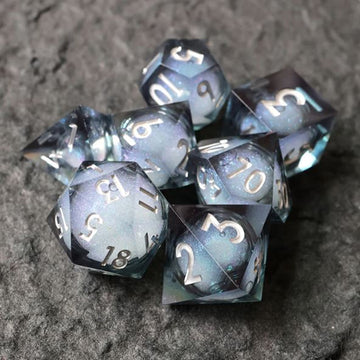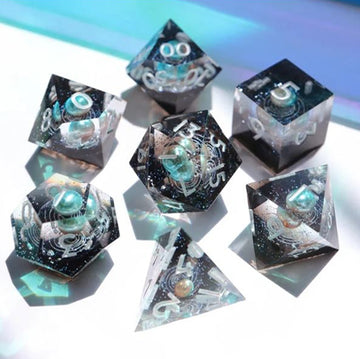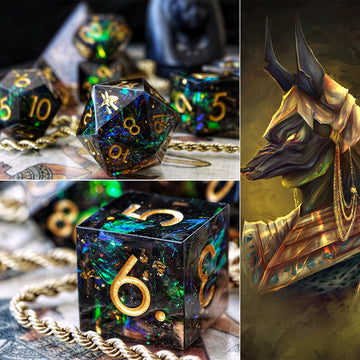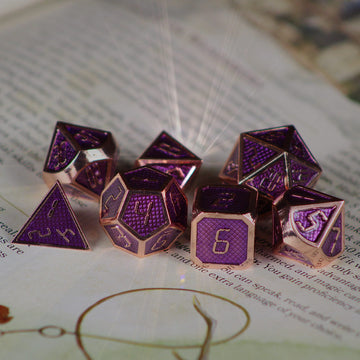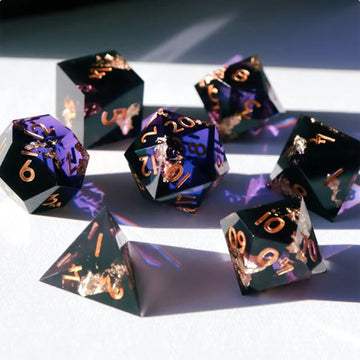Straightforward and Creative Help for New Players Creating a Fighter 5e Character
By Riley Rath
Table of Contents
- Important DnD Beginner Questions
- 6 Reasons the Fighter 5e Class is so Good
- The Limitations of the D&D Fighter 5e Class
- Step by Step 5th Edition Dnd Beginner Fighter Guide
- Archery or Melee? Your DnD Fighter in COMBAT
- Martial Archetypes: The Fighter 5e Subclassess
- DnD Fighter Multiclassing Options
- Role-Playing Your D&D Fighter Character
- Conclusion: What is the Best Fighter 5e Class in D&D?
Are you new to Dungeons and Dragons?
Did you just see the movie Honor Among Thieves and want to give the game a try? Are you worried about "messing it up"? (Spoiler... don't be!) Did literally everyone say: "First time? Oh, then definitely play a fighter"? Well... if ANY of those fit your experience.. then you've come to the right place.
The fighter class is an EXCELLENT option for beginners who are looking to enter the world of Dungeons and Dragons fifth edition.
In this guide, we will cover everything a beginning D&D player in 2023 needs to know about the 5e fighter class.
Seriously... we have got you covered on everything from sword to scabbard. We'll be talking about:
- Detailing all the fighter class's upsides and downsides
- Explaining the core mechanics
- Step by step character creation
- Options for equipment, weapons, and armor
- Showcasing every unique subclass
- Reviewing all the fighter archetypes (ex: duel wielding, tanks, duelist, etc.)
- Revealing the best multi-class options
Lastly, we will provide tips on how to role-play your fighter character effectively by developing their personality and motivations to enhance your overall gaming experience.
By the end of this guide, you'll be well on your way to mastering the fighter class in D&D 5e. Get ready to embark on an epic adventure!
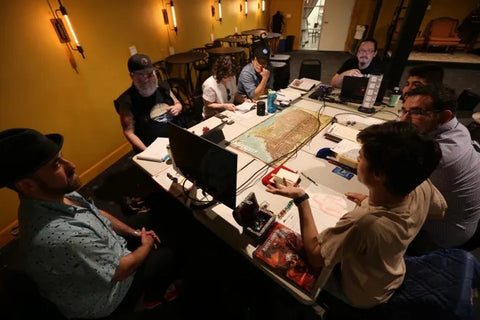
© Iris Schneider, for The Washington Post
Important DnD Beginner Questions
What IS Dungeons and Dragons?
Dungeons & Dragons Fifth Edition (D&D 5e) is a popular table top role-playing game. TTRPGs often have physical miniatures and hand drawn battle maps or terrain pieces, but can be played online as well. Regardless, they largely take place in the imagination. Players create custom characters with unique abilities and explore a fantastical world invented by the Dungeon Master.
What is the D&D 5e Fighter Class?
The fighter 5e class is one of the thirteen character classes in D&D 5e, and it focuses on martial combat prowess rather than magical abilities. Fighters can use ANY weapon... in ANY style... while wearing ANY armor... at ANY time. They are skilled warriors in any and every situation... they ARE fighters :) In other words, just like Russel Crowe in South Park, the fighter FIGHTS.
Ok... so I've said "fighter" a lot... and to be honest I'm going to keep on saying "fighter" a lot. But what do I mean by "fighter"? Like, just a dude that swings a sword?
"What are Some Examples of a 5e Fighter in Pop Culture and History?"
Nearly every work of epic fantasy has a magic-sword-wielding DnD fighter. Aragon from Lord of the Rings, Geralt of Rivia from The Witcher, King Arthur, and "The Hound" from Game of Thrones are great examples.
But each of these characters are so much more than a dude with a sword. Aragorn is the heir to Gondor's throne and a leader who inspires those around him with his bravery and determination. Geralt relies on his skills to survive, using his agility and combat prowess to overcome even the toughest opponents. King Arthur pulled Excalibur from the stone. And the Hound... well, the Hound is hella strong and grumpy... which is also helpful.

© Embracer Group
Fighter Examples in History and Fiction
Superheros: Stereotypical fighters embodied the spirit of courage, bravery, and resilience... just like superheroes! Wonder Woman, with armor, sword, shield, and rigorous combat training has been an inspiration for many fighter class enthusiasts. As has Captain America, the humble and noble embodiment of fearlessness, leadership, and devotion to his allies.
History: Not a Marvel fan? Read a history book. Great warriors like Alexander the Great, El Cid (arguably the greatest knight EVER), and Joan of Arc are perfect examples. All were determined individuals, skilled with weapons and unafraid to take risks when needed.
Literature: Prefer classic lit to comic books? The Three Musketeers and Robin Hood are also great inspiration for playing a fighter character. They are drastically different types of heroes, but they all possess a fighting spirit.
Science Fiction: Sick of swords? In sci-fi, fighters can range from brave heroes to bounty hunters, depending on the story. Some iconic examples of fighters in sci-fi include Han Solo from Star Wars, Captain Malcolm Reynolds from Firefly, and Captain Janeway from Star Trek: Voyager.
Long story short: not sure what a fighter is? Just take a cue from your favorite historical figures and fictional characters.

6 Reasons the Fighter 5e Class is so Good
You mean besides it being REALLY fun to run up and hit things with a sword (or any weapon for that matter... more on that later)???
The Dungeons and Dragons 5e fighter class features prove why it is a great starting point for players new to D&D 5e. Here are 6 reasons why:
1. They Are Easy to Learn and Play
One of the main advantages for beginners is that the fighter has veeeeery few new rules to teach players. They are a straightforward and simple class that performs well even at 1st level.
New players are already going to feel overwhelmed by more new rules because ALL the rules are new. The fighter's basic mechanics are straightforward and easy to understand, allowing players to quickly get up to speed... no problemo.
(The rest of this section covers what little this class adds to the basic rules).
2. Archer or Soldier... They Are Versatile in Combat
One of the biggest benefits of playing the fighter class in Dungeons & Dragons 5th Edition is its versatility in combat. Fighters can fight in any style and have the Armor Class and hit points to take on tough foes and survive brutal battles...
Pssst... that means you can fight any way you want!!!!
- Looking to dodge jabs and deftly slash? You can make that fighter.
- Want to draw the enemy so your allies can attack from the flank? You can make that fighter.
- Want to possess an array of special moves that allow you to fight 4 enemies at ease? YOU CAN MAKE THAT FIGHTER.
And no matter what you make, you'll be a force to be reckoned with both on and off the battlefield, because if there's one thing a dnd fighter is good at... it is ATTACKING.
3. They Can Attack... Like... A Lot
If you are a spellcaster, every level or so you need to choose new spells. These spells do wildly different things... from charming to transforming to blowing the ever living hell out of something. For a spellcaster to be a good character, they need to pour over their vast list of available spells. When you're a veteran that knows the game really well, it is really fun. But when you are new, it's kinda just homework.
Dnd fighters don't have that problem. Instead of getting bigger and more powerful spells, they get bigger and more powerful actions... specifically Extra Attacks. When using an action to make a weapon attack roll, most classes an only attack once. The fighter gains more attacks as they increase in level, and more attacks means more damage and critical hits!
No matter how powerful a spellcaster is, they can only ever cast one big spell in a round of combat (a few exceptions, but 99% of the time, that is true). But a fighter can swing their sword as many times as their attacks allow (2 by level 5, 3 by level 11, and 4 by level 20!)
4. They Level Up Ability Scores More
Fighter 5e player characters get good... FAST. Fighters increase two of the abilities scores at 4th level and again at 8th, 12th, 16th, and 19th levels.
In other words, fighters increase their ability scores A LOT. What that means for you is that your fighter character will get better at being a hero a lot faster than the wizard. Yes... the wizard will learn cool stuff like Fly and Fireball, but they will be stuck with a -2 to Strength while you have a positive modifier to EVERY SINGLE STAT. By the time you are playing at higher levels, your fighter will feel VERY powerful.
Psst! This is a great example of why the fighter is such an EASY class for new D&D players; one of its best abilities is passive... you just become better automatically!

5. They Can Get Themselves Out of Trouble
Speaking of hit points... one of the key advantages of the Dungeons and Dragons 5e fighter class is their ability to heal themselves every short rest. The "Second Wind" feature, which is like a limited well of stamina, gives you a "burst of adrenaline," turning that sword slash into a flesh wound. Mechanically, it gives fighters an additionally hit point pool that they can use as a bonus action, which is VERY handy when they are surrounded by orcs taking advantage of flanking rules...
But that's not all... at 9th level every fighter 5e character gets the "Indomitable" feature, where if they fail any saving throw, they can make a new roll instead. This is CRUCIAL at higher levels, where you will be facing more high level spellcasters that can teleport you out of combat or petrify you into stone. At 13th level and 17th level you gain an additional use of this per long rest.
6. Ability to Get Extra Actions in Combat
But if a bonus action isn't enough... how about a double action instead?! That's right, as a fighter, take two turns during one turn. Literally it doesn't make any sense... but mechanically it is a GAME CHANGER.
5e fighter's gain the "Action Surge" ability at 2nd level, which allows them to take an extra turn on their turn. Not just an action... not just a movement... AN ENTIRE TURN. So if you normally get two attacks, now you get FOUR ATTACKS.
It is this ability that makes the fighter truly heroic. I've "seen" fighters clear a path through a horde of orcs for their allies to escape... or down a monster twice their size in a single turn to the amazement of all. It really helps create exciting narratives and memorable moments during game play.
The Limitations of the D&D Fighter 5e Class
Clearly there are a lot of things about the fighter class that makes it kick ass. However, the class comes with its own unique set of features and limitations...
For instance, most fighters cannot cast any spells at all... and in a game full of magic doors and beasts and items and realms and curses... that is going to feel pretty limiting. Even the Fighter subclasses have limited spellcasting compared to other classes. Plus they lack utility spells which allow them to perform non-combat actions such as healing or creating illusions.
Furthermore, they are FIGHTERS after all... so when the story does not call for fighting, new players may feel like their fighter doesn't have anything to do.
Now, that is NOT true... you can always explore and role-play, no matter your stats! But admittedly, you may be less effective in your pursuits, or at least you will succeed on your rolls a lot less.
Step by Step 5th Edition Dnd Beginner Fighter Guide
Ok... so we've talked about the basics of the Dungeons and Dragons 5e fighter class, some inspirations from pop culture, and some of the things that make the fighter class great. Now... LET'S FREAKING MAKE ONE!
We're going to start by picking the following things in this order:
- Ability Scores
- Race
- Background and Languages
- Skills
These are the ingredients that will form YOUR fighter character... turning them from an average NPC into an unforgettable hero... so much more than the sum of its parts!
Choosing the Right Ability Scores for Your Fighter 5e Character
No matter what character class you choose, it's important to choose your ability scores wisely. They determine all your bonuses for attack rolls, skill checks, and any relevant saving throw. Basically, your hero will only perform as heroically as you imagine if their primary ability scores are good.
There are six abilities that you use any time you roll anything: Strength, Dexterity, Constitution, Intelligence, Wisdom, and Charisma.
Since the fighter class relies heavily on physical strength and endurance, Strength and Constitution should be your highest ability scores. If you want to choose a more agile fighter, then you would swap out Strength for Dexterity.
Usually, you will roll stats high/have a third higher ability to start with... but what you choose as your third "good" ability is up to you:
- Dexterity is also important as it helps with Armor Class if you use light armor and allows you to go earlier in initiative.
- Intelligence plays a role in the arcana abilities of some fighter subclasses
- Wisdom is one of the most important skills for noticing danger and understanding NPCs.
- Charisma will help your fighter avoid always fighting all the damn time.
Not sure which ability score to pick third for your fighter character? No worries, you can come back to it after you have decided on a backstory.
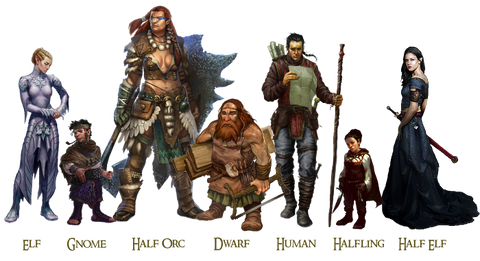
Wizards of the Coast
Selecting a Race for Your DnD Fighter
Now if your table is playing the original race rules for D&D 5e, selecting the right fantasy race can have a significant impact on your character's performance. Each race has its own set of racial traits that affect combat and non-combat situations.
For example, elves gain a bonus to their Dexterity scores, making them more suitable for archery or dual-weapon fighting styles. Alternatively, dwarves and half-orcs may have higher Strength scores, making them better suited to heavy armor and melee combat. And humans... well, humans are kind of "good at everything, great at nothing"... always a fine choice!
However... if your table is following the optional rules from Tasha's Cauldron of Everything/One D&D, then you can throw them out the window, because these variant rules are drastically different:
- TCOF: "Custom lineage" turns race really into just a fun skin for your hero. You can choose any skill to increase by 2, a single feat, a single language, and a variable trait.
- One D&D is experimenting with a huge shift in how D&D races work (ex: it gets rid of half races). So far it is not very popular with the D&D community. For more info, look here.
But aside from combat-related traits, it's also important to consider what kinds of role-playing opportunities each race presents. Some races may have unique cultural backgrounds or specific abilities (like darkvision) that can add depth and nuance to your character's backstory. Half-orcs and tieflings tend to be ostracized by society, elves and dwarves fit in best among their own, and halflings and humans fit in fine just about everywhere.

Selecting Backgrounds and Languages for Your Fighter 5e PC
You have your class (fighter), abilities (DEX or STR), and you've chosen your fantasy race. Now you gotta decide where you came from... your background.
Backgrounds impact both storytelling and gameplay: they offer guidelines for your personality and come with skills and proficiencies. The backgrounds most associated with fighters are Acolyte, Criminal, Folk Hero, Noble, and Soldier.
Think about where your fighter comes from, what events shaped their life, and what goals they have in mind. For example, a fighter who grew up on the streets (Urchin background) may use improvised weapons and be more accustomed to brawling than a noble-born fighter who was trained in sword fighting. A fighter with a Criminal background may have a harder time winning over NPCs in more lawful areas of the game world. By taking the time to craft a backstory for your fighter, you can make them feel like a fully-realized character rather than just a set of stats on a piece of paper. So take some time to consider the options and select the one that best fits your vision for your character's story.
Selecting the appropriate languages can also add depth and flavor to your fighter character. Common choices include Elvish or Dwarvish for characters with ties to those races. Or for characters with darker pasts or evil intentions, consider learning Infernal (language of deal-making devils) or Abyssal (language of rip-you-in-half demons).
Selecting Skills
Next is skills. These are the things you roll when you are trying to accomplish anything outside of combat. Each skill relies on an ability score. The better your ability score, the better your fighter will be at that skill. You also get to add your proficiency bonus to any skill you select. The fighter class allows you to choose from Athletics (STR), Acrobatics (DEX), Animal Handling (INT), History (INT), Insight (WIS), Intimidation (CHA), Survival (WIS), and Perception (WIS).
Now, you might ask: "If the skills rely on ability scores, shouldn't we choose them right after we select our ability scores?"
Well 1) you can do whatever you want... Captain Barbossa is right... many of these "rules" are more like guidelines. But 2) some of the races and backgrounds come with skills and it is just easier to choose skills after you know what you automatically get. Definitely want to make sure you choose different ones! We do this AFTER we select a background because the backgrounds come with skills and we want to make sure we choose different ones.

Archery or Melee? Your DnD Fighter in COMBAT
Now that we have the foundation of your fighter established, it's time to decide exactly how they will fight... time to tackle combat!
D&D fans usually put classes into categories for how they function in combat. For example, characters with abilities that reduce how much an enemy can move across a battlefield are called "area control." And characters that primarily assist and buff other characters are called "support." Players will usually align all their class abilities, creating a "build."
If your fighter is going to be effective, they will likely fall under one of the following builds:
- Duel Weapon Fighting: This involves using two weapons simultaneously to maximize damage output and emphasizes mobility and attack speed. It's important to note that this fighting style relies on less armor and no shield, so you are vulnerable to attack. However, for experienced players looking for a high-risk, high-reward play style, the duel-wielding fighter archetype can be a thrilling option in combat.
- Tank Fighters: Tank fighters have high hit points and strong armor proficiency, making them the ideal character to take enemies head-on. Additionally, tank fighters can also be great at controlling the battlefield by using their mobility to tactically reposition allies or enemies in combat. This archetype is best suited for players who enjoy getting right into the thick of battle and soaking up damage.
- Ranged Attack Fighters: The fighter is usually a front lines warrior, but they are equally as good at shooting from a distance with bows, crossbows, and slings. The fighting style is well-suited to players who want to stay out of harm's way while still doing significant damage.
- The Protection Build: Protectors focus on protecting allies close to you and increasing your party's survivability through inspiring allies and temporarily increasing their AC. How? Because if anyone attacks anyone other than you, you get to impose disadvantage on their roll. The Protection build emphasizes controlling battlefields with the fighter's ability to maneuver enemies, as well as providing crowd control with opportunity attacks.
- The Duelist Build: This style of fighter emphasizes facing off in one-on-one combat. They are designed to carry a shield at all times and wield one-handed weapons so they have the strength to carry their shield. They are the "standard" fighter. So if you want to be Link or Boromir... a sword and shield expert.. be a duelist! Though, of course, you could also go the fencer or pirate route... and just "engarde!" everyone.
Now... I've said it before and I'll say it again:
Fighters have proficiency with ANY weapon... in ANY style... while wearing ANY armor... at ANY time.
They are skilled warriors in any and every situation... they ARE fighters... so have at it, get creative! However, it's kinda like having 500 channels on TV... lots of weapon options, but not many true differences. D&D 5e is simple, and one way it stays simple is by not having much variety in the mechanical bonuses of weapons. But there are still some important distinctions to pay attention to. After all, it would be very silly to want to be an arcane archer and choose feats, fighting styles, and weapons designed for an executioner!

Weapons Your 5e Fighter Can Wield
D&D is a little strange in that the damage you do when you hit someone is determined by the weapons; all weapons have a damage die associated with them. Most weapons do between 1d6 and 1d10 damage (daggers do 1d4 and a few BIG weapons do 1d12 / 2d6 damage). Weapons do different damage types (slashing, piercing, or bludgeoning), and some monsters and enemies are resistant to those damage types. So be sure to have access to weapons of each damage type.
Here are some of the best weapons for fighters:
- One-handed weapons like longswords or maces
- Two-handed weapons like greatswords or halberds
- Ranged weapons like longbows and heavy crossbows
Selecting Your Fighter's 5e Armor
Speaking of defense... gotta get some armor! If you are playing a fighter that relies on quick slashes and fast movement, you will want to stick to light and medium armors. However, if you are so close to a monster you can smell their breath, you'll definitely want heavier armors that offer more protection. These don't hurt your movement speed, but have the downside of discounts on any attempt to be sneaky. In addition to weapons and armor, you may also want to consider shields for added protection against powerful blows.

What Fighting Style is Best for a 5e Fighter Character?
Once they reach 3rd level, your fighter picks their fighting style. This style should conform with the weapons, armor, primary abilities, and build you are hoping for. You want to use it when you take the attack action as much as possible. For example, you don't need a bonus for swinging a greataxe when you plan on throwing a lot of javelins!
- Archery: Better chance of hitting with a +2 to all ranged attack rolls.
- Blind Fighting: Fight in utter darkness with blindsight!
- Defense: Basic, passive bonus, but AC is hard to raise... gain a +1.
- Dueling: If you have a shield and a one-handed melee weapon, add +2 to damage rolls... similar to a two-handed weapon!
- Great Weapon Fighting: Always hit hard with a two-handed weapon by rerolling 1s and 2s for damage.
- Interception: Reduce the damage on anyone hit by an attack near you.
- Protection: Need a shield, but allows you to impose disadvantage if a bad guy targets anyone next to you.
- Superior Technique: Get some battle master maneuvers early.
- Thrown Weapon Fighting: A game changer that allows players to hurl axes, javelins, and throwing knives by adding +2 damage and free "reload."
- Two-Weapon Fighting: Allows you to add damage to your duel wielding bonus action attack.
- Unarmed Fighting: Turn your fists into 1d6 weapons.
Best Feats for Fighter 5e Characters
Feats are things you can take INSTEAD of leveling up ability scores. Since the Fighter levels up more than other classes, a lot of players add feats to their fighter. However, they complicate a class with more customization and require intimate knowledge of the game to prove satisfying.
However, if this isn't your first rodeo, selecting the right feats can really enhance your fighter's abilities. Great Weapon Master and Sentinel can increase a fighter's damage output. Crossbow Expert allows for greater efficiency when using crossbows, and Sharpshooter will let you snipe with any ranged weapon. Additionally, feats like Alert and Defensive Duelist can help a fighter stay alive in combat.
For a list of all the D&D 5e feats, check out All DnD.
Other Gear
Adventuring ain't all spells and swords... you gotta eat and sleep! That is where equipment comes in, and the fighter can choose between a dungeoneer's pack and an explorer's pack. Both will help with surviving the wilds, but which one is best?
Honestly... they are both kinda the same. But you'll want o pick up other tool kits and packs as you adventure. Ask your DM about what you have to do to learn to use a herbalist kit to make potions, or thieves tools to pick locks!

Martial Archetypes: The Fighter 5e Subclasses
Every D&D class has subclasses that allow players some specialization for their characters. Once they reach the 3rd level, fighters have access to subclasses called "archetypes"... It's what keeps every fighter from only being a gal that hits something with her sword. They gain new bonuses at 7th level, as well as levels 10, 15, and 18.
When choosing an archetype, it's important to consider what kind of fighter you have already built. Are you flexible or strong? Do you rely on power or are you precise? Are you a lone wolf or a leader of fellow soldiers? Do you adventure to slay the wicked or protect the innocent? Are you skeptical of magic, curious about its potential, or eager to weave it into your weapons?
There are nine different D&D 5e fighter archetypes available to fighters, each with additional features and abilities:
- Champion (PHB): This is the fighter class most Dungeon Master's suggest to brand new players with literally no experience with DnD. Why? Because it is the simplest of them all! It's the "fighteriest-fighter," making it easier to perform feats of physical prowess (Strength, Constitution, and Dexterity checks), making it super easy to score a critical hit (by 20t level, and 18, 19, and 20 has the potential to do 200% damage!)
- Battlemaster (PHB): Most players narrate fighting tactics to add flavor to what is really just a dice roll. But this subclass makes them mechanics. The Battlemaster fighter is given some "superiority dice." You can spend a superiority die to use maneuvers to make combat more strategic and interesting.
- Eldritch Knight (PHB): This martial archetype is based on the idea of Arthur hanging out with Merlin all the time; eventually he would pick up a spell or two. It combines weapon mastery with the magic from the Evocation and Abjuration schools. You can add magical damage to your attacks, blast from afar, or throw up a magical shield to save you from a back stab.
- Arcane Archer (Xanathar's): This particular style of fighter not only focuses on long ranged attacks, but allows you to add magical damage (and get past standard martial weapon resistances) and even curve your shots! You can choose from a limited number of "Arcane Shots," allowing you to do things like banish or restrain your enemies if they fail your spell save DC.
- Cavalier (Xanathar's): Whether with a bow or a lance, this is the mounted warrior, demonstrating unparalleled mastery of riding a steed. But their benefits extend beyond mounted combat: they are about controlling the battlefield, using their high armor class and HP to punish enemies that attack allies instead of themselves.
- Echo Knight (Wildemount): This is a VERY powerful class... but comes with some complicated movement rules. Move about the battlefield by teleporting via timelines... allowing you to increase the number of attacks and swap spots with a different version of yourself.
- Psi Warrior (Tasha's): Be a Jedi! The Psi Warrior uses mental energy to create psychic protective fields and move objects telekinetically. You have limited psychic energy dice, which you roll and add the total to your attacks and saves. The flavor of this class is perfect for a futuristic, githyanki/mindflayer or Eberron campaign.
- Purple-Dragon Knight (Sword Coast...): For those that equate fighter with knight, this is the subclass for you. These fighters are the noblest of knights at home in the royal card as much as the battlefield. This class stresses the importance of charismatic skills and abilities, allowing you to take a more active role in social encounters.
- Rune Knight (Tasha's): These fighters are inspired by the ancient wisdom of giants, carving elemental runes into their weapons. They gain more runes as they level up, each providing detailed advantages, making it one of the more complex dnd 5e fighters. They also become more like giants, able to grow to large size and gain advantage on strength checks and saving throws.
- Samurai (Xanathar's): The most offensive of the fighters, you have a limited number of "fighting spirit"s you can use to get advantage on attacks, gain temporary hit points, and strike with deadly perfection. You also gain skills to help in social situations, continuing the flavor of a warrior fully in control of their mind and body.
For more information on the fighter subclasses, check out RPGBOT... can't sing their praises enough!

DnD Fighter Multiclassing Options
Multiclassing is when your character is both a fighter and another class. It allows you to combine the benefits of both classes. However, multiclassing requires specific ability scores, so make sure your fighter meets those requirements before branching out. For instance, if you are planning on multiclassing into a caster class, it may be necessary to increase your Intelligence or Wisdom score to use spells effectively. You will probably need to explain in your backstory why your character is a multiclass.
Fighter/Barbarian
One popular multiclassing option for fighters is to combine it with the barbarian class. When it comes to armor class, it's not a very good match, but when it comes to offense... hoo boy. Fighters also have access to Action Surge, allowing them to take an extra action on their turn, and a barbarian's Reckless Attack can give them advantage on EVERY SINGLE ONE OF THOSE ATTACKS.
Fighter/Rogue
For players looking to combine the martial prowess of a fighter with the utility and skill of a rogue, the fighter/rogue multiclass build is an excellent option. This build allows fighters to add some finesse to their combat style by utilizing the Sneak Attack damage bonus provided by the rogue class. Additionally, this build grants access to valuable skills including Acrobatics, Perception, Stealth, and Investigation, which can be used both in and out of combat.
Fighter/Warlock
Some say the warlock class was tailor-made to just be a multiclass option! This combination adds a little bit of spellcasting, some special abilities, and a whole new spin on why your fighter fights (paaaaaatron!). As a bonus, both of their abilities rely on short rests, so you can always easily recharge!

Fighter/Paladin
The fighter/paladin combo is a popular option for players who want to have tank-like survivability while increasing the fighter's offense with the legendary divine smite, which will allow you to do massive amounts of damage to your enemies. In addition, you also get access to some useful spells from the paladin class, such as protection from evil and good, and cure wounds. Be warned, though: the paladin has some background and role-playing restrictions... not nearly as versatile as the fighter!
Fighter/Wizard
This fighter/wizard build offers a unique balance of melee and magic, allowing you to take on multiple roles in combat and helpful cantrips outside of combat. Granted, there already is the "Bladesinger" wizard and "Eldritch Knight" fighter, but both of those are more like dipping your toe in the other class's water rather than truly multiclassing.
"What About Tasha's Cauldron of Everything?"
Tasha's Cauldron of Everything is an expansion for D&D that contains new player options, subclasses, and spells. One of the most significant updates in Tasha's Cauldron of Everything includes a feature that allows players to swap out their character's ability score improvements with different skills. This is a much-welcomed update for fighter characters because they can now focus on skills other than strength! It also updates the "fighting style" feature, allowing fighters to pick two styles to specialize in combat.
Other new features include:
- Fighter's Determination: use a bonus action to give yourself advantage on attack rolls for the rest of the turn.
- Improved Criticals
- Expanded weapons list
- Powerful defensive maneuvers and tactics.
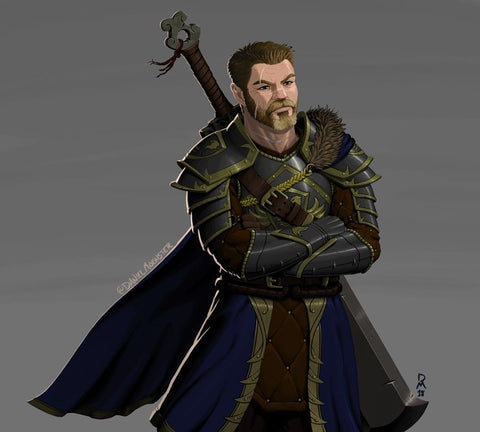
© Daniel Moenster
Role-Playing Your D&D Fighter Character
So far we have talked mostly about all the STUFF your fighter can do. Stats, abilities, weapons, powers... stuff like that. But Dungeons and Dragons is not just a war game... it is also telling a story. Together with your friends, you improv and act your characters and tell a story together.
That means when you create your 5e fighter, you have to consider more than damage from weapon attacks.
This is why you don't save the backstory for the very end... it is important to consider the personality and character of your character as you are fine tuning how they fight. But now that we have the backstory and have decided how your fighter will fight... it's time to flesh out exactly who they are so role-playing becomes more enjoyable and immersive.
Create a Personality
The best guide a player has for role-playing is found on the right side of the character sheet. These are the Personality, Bonds, Ideals, and Flaws of your beloved character. Additionally, choose goals for your character that can shape their actions and interactions with other characters.
When fleshing out their personality, put yourself in your character's shoes. Consider how their past experiences have shaped their outlook on life. What do they laugh at? What bores them? What do they do when they have downtime?
Consider their motivations... why do they adventure? Fighters are often driven by a desire for glory, honor, and recognition. They may also be motivated by a sense of duty or need to protect others, even if they are independent and rely on their own strength and skill rather than relying on others.
Develop Their Own Voice
Now that you have a character for a story and build for a game, you have to decide how you will role-play your fighter! Role-playing sounds scary, but it's really just improv acting. Some D&D players dress up, and some go full LARP, but the vast majority just pick and accent and do their best!
Discover What Roll Your Fighter Will Have for the Party
As stated... many times... throughout this post, fighters are good at fighting. All of their mechanics and bonuses are geared toward making them a force to be reckoned with in battle. But in fifth edition Dungeons and Dragons, combat does not dominate play time like it has in previous editions. So how on earth can you have fun role-playing your fighter in all the social and exploration encounters littered throughout the campaign?
Good news: you don't need mechanical bonuses to have fun role-playing!
Admittedly, you will not be as effective at convincing the shop keeper to give you a discount as a bard, as capable of intimidating a captive as the fiendish warlock, or as efficient as the wizard casting utility spells looking for traps...
BUT... that doesn't mean you have to sit there and do nothing! As you play and get to know the other players and characters, you will find a gap that your fighter character can fill. Maybe you are a battle hardened soldier who makes quick decisions with their gut? Or maybe you are a young warrior who is looking for some glory? Or maybe you are a grizzled mercenary who constantly comes alongside the younger members of the party, helping them cope with the traumas of combat.
Just because you get an A+++ for combat encounters doesn't have to stop you from experiencing the other two pillars of D&D 5e!
Narrate All of Their Actions For the Table
But sometimes you won't be "in character"... sometimes you will just be narrating what your fighter is doing. This is especially true in combat. Don't just say "I attack again"... describe it! Use passion and emphasis like you really are the fighter yourself!
Choose words and phrases that reflect their martial prowess and tactical style. Use descriptions such as "charging," "parrying," and "felling" to evoke images of combat and strategy. Tell everyone at the table what your fighter is thinking and feeling as situations arise by putting yourself in their shoes. The narration of your fighter should reflect their individuality and make them stand out from other characters in the game.

Conclusion: What is the Best Fighter 5e Class in D&D?
Long story short: whatever you think is the most FUN! The fighter class is as strong and balanced as it is versatile. You can optimize a fighter 5e character to snipe enemies from a distance, lead a cavalry charge, or face a giant in one-on-one combat.
That said... congratulations! You have taken the first step toward mastering the fighter class in D&D 5e. If you follow this guide, your fighter is sure to kick ass in whatever way you see fit! Allow me to virtually and imaginatively shake your hand.
All that's left... GO PLAY!
We all learned how to play Dungeons and Dragons by PLAYING with others.
Just like a squire could only become a knight by fighting... you can only truly become a skilled fighter by playing with your friend :)
We're Glad We Could Help You Learn the 5e Fighter Class
Now Pair Your Fighter With Their Own Inspired Dice!
Triton Copper-Blue Metal Dice Set
Get Your D&D Fighter 7-Dice Set NOW
Riley Rath

Riley is a freelance tabletop games copywriter, content writer, and marketer based out of Spokane, WA. When not playing or writing about board games or DnD, he is busy with family, hiking, cooking, and gardening... very hobbit-like for a 6'4'' dude.



